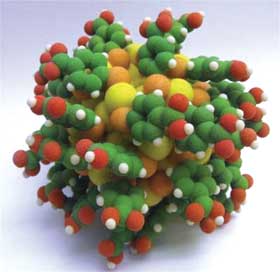Compiled by EuroPhotonics staff
A recent spectroscopic study has revealed fingerprint features of
single crystals of nanometer-scale gold particles, and researchers say the information
could be applied to catalysis, sensing, photonics, biolabeling, drug carriers and
molecular electronics.
The single crystals were created in 2007 by a group of scientists
at Stanford University in California. Prepared in a solution from gold salts, the
particles’ reactive gold cores can be stabilized with various organic ligands,
scientists discovered in the mid-1990s. Particularly stable particles can be synthesized
by using organothiolate ligands that have strong chemical interactions to gold.
The Stanford scientists made single crystals for x-ray diffractometry
that contained only one type of a particle having 102 gold atoms and 44 thiolate
ligands – also known as the Au102(p-MBA)44 particle. The structure was reported
in Science in late 2007. Further analysis at the University of Jyväskylä
in 2008 resulted in a theoretical framework that was used to understand the stability
and electronic structure of the unique particles. Findings were reported in the
Proceedings of the National Academy of Sciences.

An atomistic model of the Au102(p-MBA)44 particle. The yellow portions indicate gold, orange: sulfur, green: carbon, red: oxygen, and white: hydrogen.
Collaborating with the Stanford group, researchers from the department
of chemistry and the Nanoscience Center at the University of Jyväskylä
reported the first full spectroscopic characterization of the absorption of electromagnetic radiation by the particle in both solution and solid phases. The study was performed over a wide range of the spectrum – from the mid-infrared to the ultraviolet.
The scientists documented clear “fingerprint” features
in the absorbance spectrum that they believe can be used to benchmark chemical modifications of the particle for various applications. By observing a bandgap of 0.45 eV, they established the molecular nature of the clusters. They also analyzed the features
from large-scale computations using the gold structure to fully understand the particle’s absorption characteristics.
The findings appeared in the Feb. 24, 2011, issue of the Journal
of the American Chemical Society (doi: 10.1021/ja111077e).